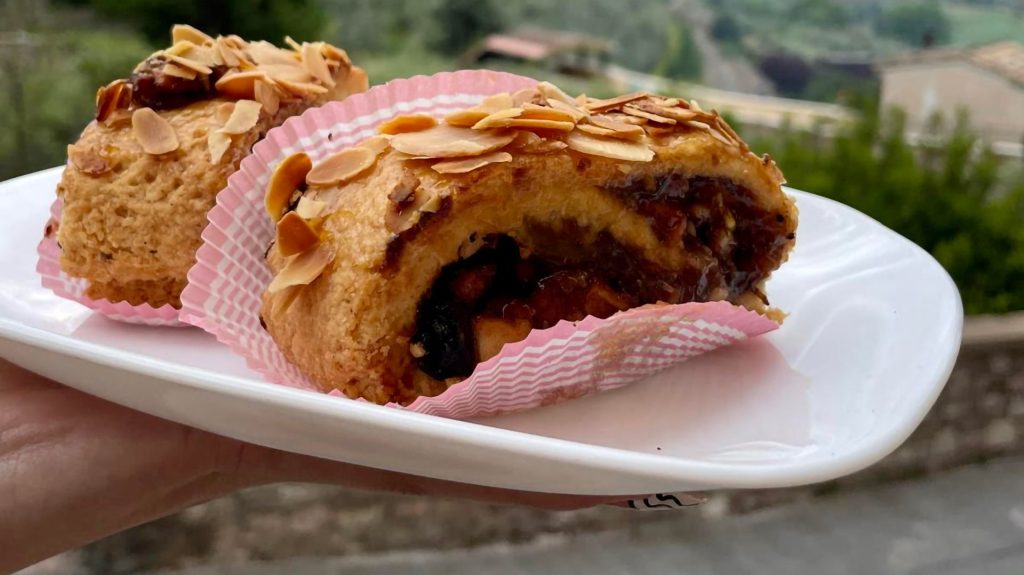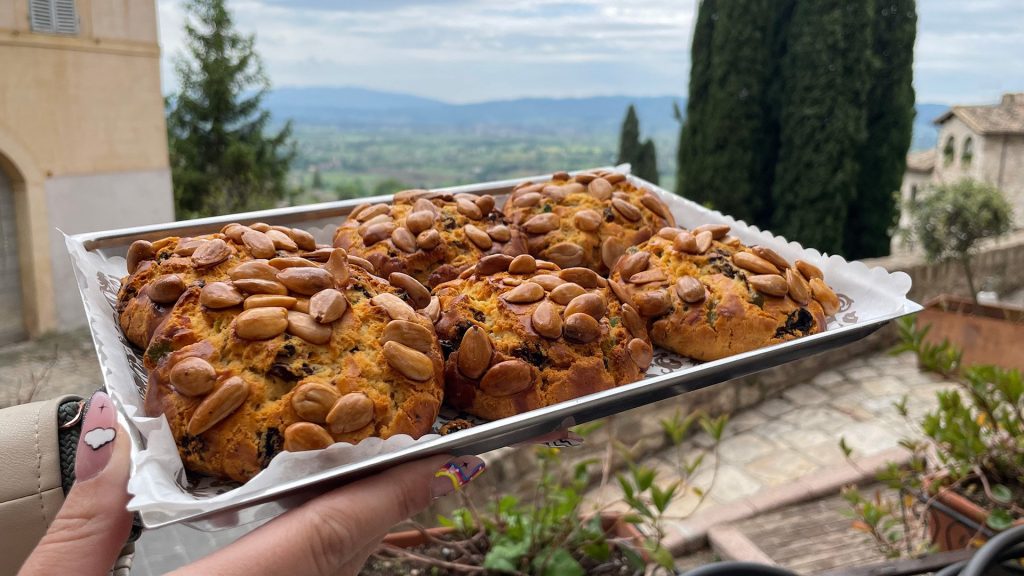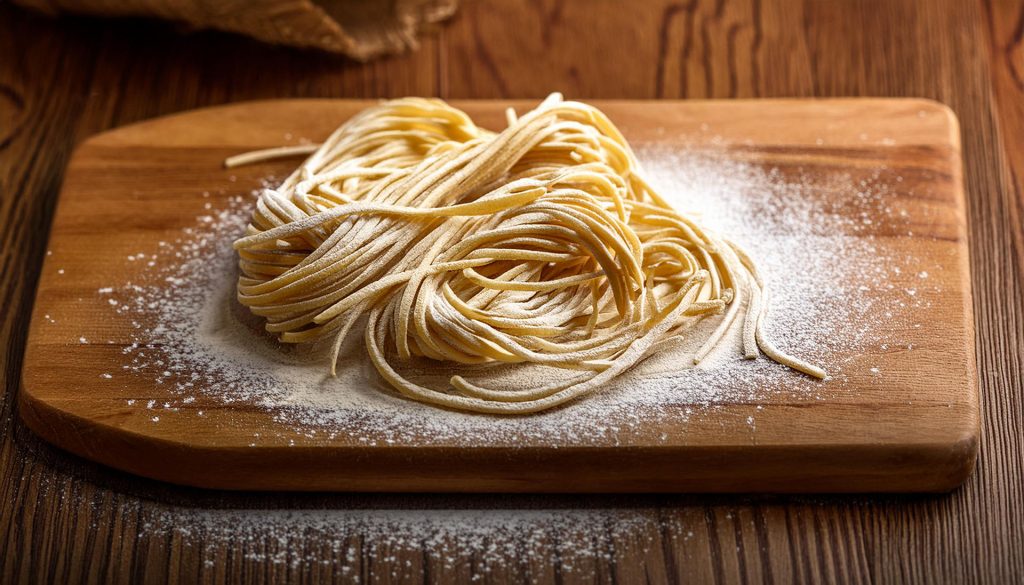As is the case throughout Umbria, fine dining in Assisi is an art, where top quality and authenticity are the main ingredients.
Traditional dishes range from the torta al testo [unleavened bread], eaten as a side dish or filled, first courses enhanced with truffle harvested in the vicinity of the town, to many cakes, such as the rocchiata or pane di San Francesco [similar to strudel], all of which are products that preserve and hand down the stories and traditions of the area.

Mostaccioli are local, diamond-shaped biscuits, made with simple ingredients, such as bread, honey, almonds and grape must, which gives them their unusual name.
These biscuits are linked to the history of the town and to the figure of St. Francis. It is believed that those prepared by Jacopa Settesali, a Roman noble lady and her dear friend, were his favourite desserts, which he asked for on his death bed. Francis’ passion for a local dessert shows his bond with ordinary people. Even today, these biscuits remain a symbol that encapsulates history, culture and spirituality in every bite.

Rocciata is a delicious, fragrant dessert with a typical, local filling. It is made with puff pastry filled with apples and dried fruit “arrocciata”, i.e. rolled around itself. The shape gives it the name of rocciata, used in Foligno and Assisi, whereas it is known in other areas in Umbria as “attorta”.
This dessert used to be prepared during religious festivities, such as All Saints Day, Day of the Dead and Christmas, but it can be eaten all year round.
You can always find plain rocciata anywhere in Assisi according to the traditional recipe or in many different versions enriched with pears, rum, cocoa, cinnamon, jam, dried figs, pine seeds, Viin Santo [sweet white wine], Alkermes and much more.
You can just choose one or try them all!

Pancaciato, also called pan nociato, is a little savoury roll with pieces of cheese, pepper and walnuts that is very popular in Assisi and the surrounding area.
Pancaciato has very ancient origins rooted in Umbrian rural tradition and linked especially to the housewives’ creativity. It is said that in order to celebrate St Martin, the housewives enriched their bread dough with the few things they had available in the autumn.
The link with this festivity created a variation using a glass of red wine or raisins added to the mixture as an excellent contrast that enhances the taste.

Pane di San Francesco, also called “pagnotta francescana”, is a leavened dessert with honey, enriched with raisins, candied fruit and sometimes almonds.
The recipe has very ancient origins. In the Middle Ages, the Franciscan friars prepared this loaf in honour of St Francis and during the most important religious festivities, to symbolise abundance and sharing.
As you walk through Assisi, you can find two versions of Pane di San Francesco: the first is lighter and similar to a brioche, whereas the second looks like a biscuit.
Both versions are often eaten with the wine of St. Francis, a sweet, fortified, amber-coloured wine.

Torta al testo is an ancient Umbrian recipe and resembles a large, usually round-shaped flat bread, about one centimetre thick that is then divided into slices and served with the meal, or cut in half and filled as you wish with cold meats, cheeses and vegetables.
It is a typical flat bread, using a dough made with flour, water, extra virgin olive oil and a pinch of salt and to make it rise, some people add a pinch of bicarbonate of soda or beer yeast.
It began as a daily substitute for bread and shows the geniality and adaptability of the local population.
The bread takes its name from the tool used to cook it. It is actually cooked on a brick or cast iron disk called “testo”, and placed on glowing embers.
You can find it in other areas of Umbria with other names: in Gubbio it is known as “crescia”, in the area of Città di Castello it is called “ciaccia” and in Terni they call it “pizza sotto il fuoco” [pizza under the fire].

In the Baci di Assisi, the unquestionable protagonists are almonds, both as thin roasted petals on the surface and in the mixture consisting of almond paste.
The original recipe uses almond flour, sugar, sliced almonds, egg white, honey and orange zest. They are sometimes embellished with pistachio nuts.
Although it is difficult to trace the precise origins of these sweets, it is believed they may be linked to an episode in the life of St. Francis. According to legend, after kissing a leper, the Saint experimented an inner transformation passing from sour to sweet, just like the taste of the Baci di Assisi.
These Baci not only delight the palate, they also represent a piece of Assisi’s history and culture and invite you to discover a crispy casket with a soft centre hidden inside.

Strangozzi are a typical shape of pasta in Umbria, known as either stringozzi or strengozzi depending on the area. This poor man’s dish from the local rural culture is made using the simple ingredients of soft wheat flour and water. The strangozzi’s long, rectangular shape resembles the leather shoe laces of old.
They date back to the 16th century Papal States, especially the period of the revolutionary uprisings against ecclesiastical power due to the salt tax imposed by the Church. The name “strangozzi” suggests a rebellious origin, as it conjures up the act of strangulation.
Although they are not originally from Assisi, they have been adopted by the town where they are served with local condiments. Strangozzi with black truffle are regularly served on the menus of Assisi’s restaurants.